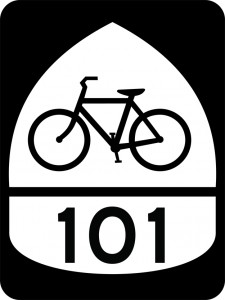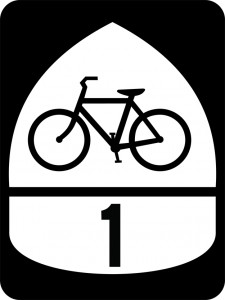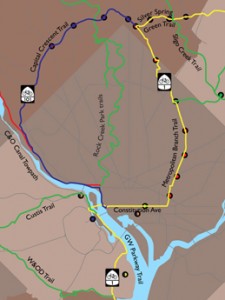Did you know that the United States has signed bicycle routes? You didn’t? Yeah… don’t feel bad, nobody else seems to know about them, and I only stumbled upon them trying to do this month’s Wikiglean. Obscurity notwithstanding, two bike routes do exist and the legal framework is still around – and right now is just the time to breathe life back into the system and make them serious transit.
Back in the 1970s, after the shock of the Oil Crisis, planners – AASHTO even – had the forward idea of determining and assigning interstate bike routes. Primarily meant for low-traffic roads or dedicated trails, the routes were to connect cities for touring purposes. However, by 1982, only two routes had ever come into being, and so the system went the way of the DMC-12. But conveniently for Washingtonians, the two existing trails currently run through Virginia and one is poised to benefit the Washington Metropolitan area.
The less relevant route begins in Illinois and terminates at Yorktown National Battlefield The one that matters for Washingtonians starts in North Carolina and passes into the DC area on the Mount Vernon Trail, entering the city on the Theodore Roosevelt Bridge. Now, DC never signed any sections, but with the potential completion of the Metropolitan Branch Trail and the Capitol Crescent Trail as legitimate transit routes for both touring and commuting. Just as a concept, I propose designating Constitution Avenue, the Metropolitan Branch Trail, and the Silver Spring Green Trail BR-1. Eventually, extension out from DC and throughout the United States would follow, as plans advocate.
In keeping with the highway principle of spur assignations, a bypass route on the Capital Crescent Trail to its terminus in Silver Spring would then become BR-101. The quiet, leafy route would skip downtown’s bustle while still serving as a route for some Maryland commuters. Considering part of the trail’s imminent transformation into a major local corridor with the construction of the (misnamed) purple line, it offers a financial and symbolic opportunity for states to begin serious investment in bicycle networks.
The social impact of having these relatively simple and cheap designations would be enormous. Creating routes would set goals and frameworks for DC and Maryland to finish their trails and treat them as transit. Having a US Bike Route sign standing alongside the iconic US Highway sign will remind motorists of the rightful place of bicyclists on the road and in the budget.
These particular routes, traveling by the Capitol and through wealthy suburbs, would demonstrate that the administration is putting its money where its mouth is and experimenting with transportation on its own turf. Likewise, having the first of these projects be inside the Beltway would inform tourists of their existence. Consider how many people in America – including busloads of teenagers whose tastes and styles will influence pop culture – visit DC every year? Bike lanes in front of the Ellipse would send a powerful signal to America, for sure.
Yet much as it offers a great photo op for the Obama administration or Mayor Fenty, designating the trails or roads as federal-aid highway routes significantly reduces the funding process for improvement projects. Routes that serve as transportation corridors rather than recreation trails are legitimate sources of direct federal aid, under 23 USC §217. The difficulty DC has had in completing the Metropolitan Branch Trail should indicate how better funding and more political currency are direly needed. However, it seems mostly that this is a consequence of the small number of bicycle commuters and their limited cultural influence, essentially meaning that national advocacy is largely a PR effort to convince decision-makers that bikes can and do work as everyday transportation.
Locally, As more trails and bike routes are declared in DC, these routes will become even greater connections throughout the region. More connections mean more timid riders trying out the safety and certainty of bike trails and lanes. I can’t guarantee that BR-101 will be the new I-270, but for people unfamiliar with DC, it might be best to explain how this already fits into the local network, to emphasize its potential. DC has proposed an extensive trail and route network. Now, the map I put together only shows the major trails, so it’s worthwhile describing the route in greater detail.
Starting from the northern end of the extant route on the Mount Vernon Trail, the path would split east of Arlington National Cemetery, crossing the GW Parkway and the Boundary Channel on existing bridge space (Street View). Continuing on, it would connect to the inaccessible south pedestrian ramp of the Theodore Roosevelt bridge (Street View), using it to enter DC. Turning off of the bridge at the end of I-66, BR-101 would split off and follows the Rock Creek trail to K street, and on K Street to the Capital Crescent Trail. BR-1 would travel on the roadway of Constitution Avenue to the Capitol and then to Union Station, providing access to the new bicycle facility on 1st St NE, in addition to rail transit. From there, the route goes up the Metropolitan Branch Trail to the satellite city of Silver Spring. In Silver Spring, the two routes reconnect at the transit center and travel up the Silver Spring Green Trail on Wayne Avenue and beyond. I don’t know enough about possible routes beyond that, but corridors could certainly be found, perhaps taking it to Konterra before reaching Baltimore and heading northward, presumably to meet up with some trail forged by Transit Alternatives through the thicket of New Jersey.
Along the way, both routes connect with all sorts of transportation systems and urban nodes. BR-1 connects Alexandria, Downtown DC, Rosslyn and Silver Spring. BR-101 connects Georgetown, Somerset, Bethesda, and Silver Spring. Although these routes already exist in parts, connecting them would create a comfortable network for riders of all abilities to travel all over the city, linking up more and more locations through a network effect, as they link other trails, lanes, and routes that then go further out. At many locations, they tie into other modes of transportation.
Combined, both corridors pass 15 Metro stations on every single line, as well as buses, commuter rail, and future streetcars. At Fort Totten, a branch splits off to go to West Hyattsville and the Sligo Creek and Northwest Branch trails. and it should also connect to the future Circle Forts Trail. In Bethesda, BR-1o1 would connect to the Little Falls, North Bethesda, and Rock Creek trails Finally the existing portion in Virginia links to the heavily-used W&OD trail via the Custis and Four Mile Run trails. With enough connections, it might not be unreasonable to deliver goods by bike or cargo trike or run errands a few miles away. Bicycle transportation would then clearly have more visible relevance as transportation.
So, that’s my unsolicited speculation on the matter of bike routes. It’s just some thoughts on a particular case, but I think the thought behind it – that bicycles used for commuting and personal transit deserve the same federal funding that goes to commuters and shoppers on US-50 or US-29. The National Bike System are an idea that should not have died in the 80s, and one that deserves new attention as the United States takes steps as an institution and a nation to live more sustainable lives.



The BR-1 signs appear in Southern Fairfax and Eastern Prince William Counties, along VA-123 and adjoining trails, as well as in places along the US-1 corridor. Several of us have wondered if BR-1 more-or-less parallels US-1 along the coast.
I concur that bicycle transit deserves support, too, and that a national network of routes would be a wonderful thing.
I plan on running for Congress in 2010, and have included an ad hoc plan for a cyclist interstate paralleling the regular interstate highways throughout the United States.
I am in Congressman Reyes district, the dud on the House Intelligence Committee and fighting hard to get him out of office by ejecting in the Democratic primary hopefully.
I myself have a Raleigh Detour Deluxe and ride it everywhere. Good bicycle and is the ultimate hybrid urban bicycle.